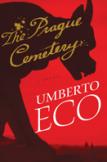Devious History
The Prague Cemetery is a dark and cynical novel filled with detailed historical allusions and personages, as well as the clever wordplay readers have come to expect from Umberto Eco. Employing three narrative voices—those of Simone Simonini (the only fictional character in the novel), Abbé Dalla Piccola (who may or may not be a figment of Simonini’s imagination) and the Narrator (an intrusive character who speaks directly to the reader)—Eco constructs a 19th-century universe in which the anti-Semitism forged and frequently re-drafted as The Protocols of the Elders of Zion becomes the raison d’être for the Third Reich.
While the Old Jewish Cemetery in Prague provides a specific, historical locus for the alleged Jewish conspiracy to conquer the world, it also serves as a conduit for Eco’s larger purpose. As the novel illustrates, history is not so much recorded memory as active scripting. In this text, what actually happened, or happens or (as Eco implies) will happen, is always trumped by characters like Simonini, who revise, rewrite and restage events. His heinous roles as forger, murderer, spy and all-around deceiver recast and permanently alter individual lives, complicate national and international relations and initiate new grudges, all the while deepening age-old prejudice against the Jewish people.
Though Simonini makes good money from his forgeries, he finds himself dejected and without purpose. Just four pages from his story’s conclusion, he asks, “What had been causing the emptiness I had been feeling for weeks, other than a sense of no longer being a protagonist?” In this novel, the hero is simply that, a protagonist, one who acts and whose actions gather the forces of his world around him. While the hubris characteristic of tragic heroes is Simonini’s, a final realization of himself as merely human eludes and therefore does not redeem him. By novel’s end, Simonini clearly defines himself as a fully realized solipsistic zealot: “I realize the whole purpose of my life has been to bring down that accursed race. Rachovsky [of the Russian secret service] is right: hatred alone warms the heart.”
Through pages of sometimes tedious scenes of greed, perversity and abuses of proper authority in state and church (here the Jesuits, “the Lord’s octopuses,” figure prominently), Eco incorporates each of the seven deadly sins into the novel’s pages. Satanic rituals, rape, physical abuse, wrongful accusation, unwarranted punishments, falsehoods, close-range shootings, the dumping of inconvenient bodies into sewers and the stealing of sums both large and small work in concert to discredit and destroy an entire people.
As was widely reported when Eco’s sixth novel was initially published in Italy, both the Chief Rabbi of Rome and L’Osservatore Romano expressed strong criticism of the book. Numerous characterizations of the Jews in both the text and the illustrations are indeed negative and jarring. In Chapter Two, Simonini credits his grandfather’s vocal and public hatred of the Jewish people for imbuing him with his own lifelong animosity toward them. Grandfather’s litany of supposed Jewish faults and aberrations comprises a two-page catalog of vitriol. That list and further disparagements in the text are balanced by the sheer degraded humanity of Simonini and the other Jew-haters in the narrative. So unsavory and despicable are their prejudices and actions that any attentive reader is sure to consider their anti-Semitic dialogue and diatribes in light of the characters’ own lacks and perversities:
But why philosophize instead of piecing together events? Perhaps because I need to know not only what I did before yesterday, but also what I’m like inside—that is, assuming there is something inside me. They say that the soul is simply what a person does. But if I hate someone and I cultivate this grudge, then, by God, that means there is something inside! What does the philosopher say? Odi ergo sum. I hate therefore I am.
The novel appears to move beyond Simonini and his accomplices, even past the Jews and the horrific Holocaust, asking its readers to consider any and all history shapers, forgers of any cultural saga, as Simonini’s clones. Perhaps Eco is even punning on the word plot, in the interactive game with which he engages his readers. In the Prague cemetery—amid many plots—there is the alleged Jewish plot to conquer the world. There is the forged plot of the Protocols against the Jews. There is the plotting between and among historical figures, political parties, religious orders, masters and slaves, writer and subject. And, of course, there is the novel’s plot itself.
Does Eco do with us as Simonini does with The Protocols of the Elders of Zion? Does he revise and rewrite history so his readers, distracted and hoodwinked by his deft telling, come to accept his story as the “true” one? Does he respect the thousands who have made for the novel’s booming sales? Or does he reduce us to one of the two types of readers he imagines possible in his prefatory note?
I am expecting two kinds of readers. The first has no idea that all these things really happened, knows nothing about nineteenth-century literature, and might even have taken Dan Brown seriously....
The second, however, knows or senses that I am recounting things that really happened. The fact that history can be quite sodevious may cause this reader’s brow to become lightly beaded with sweat. He will...suspect that these things could happen again today. In fact, they may be happening in that very moment.
This article also appeared in print, under the headline “Devious History,” in the March 5, 2012, issue.








